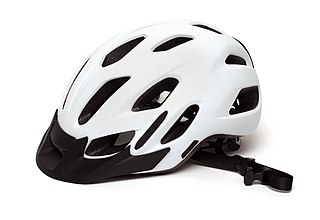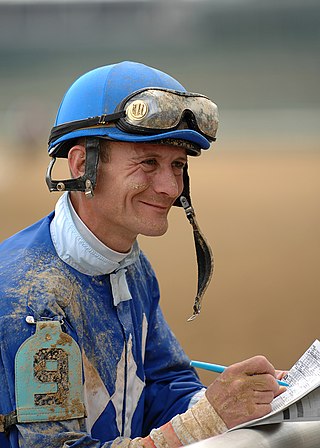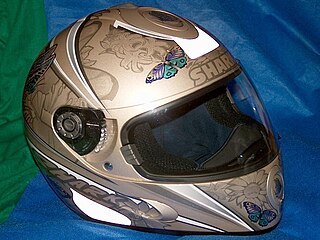
To improve motorcycle safety many countries mandate the wearing of personal protective equipment such as protective clothing and helmets. Protective clothing may include certain types of jackets, gloves, boots, and pants. Jackets meant for motorcyclists are typically made of leather or specialized man-made fabrics like cordura or Kevlar. These jackets typically include padding on the elbow, spine, and shoulder regions. This was once quite bulky, but modern technology and materials have made it unobtrusive. Gloves are generally made of leather or Kevlar and some include carbon fiber knuckle protection. Boots, especially those for sport riding, include reinforcement and plastic caps on the ankle and toe areas. Pants are usually leather, cordura, or Kevlar. Except for helmets, none of these items are required by law in any state in the USA, or in any part of the UK but are recommended by many of those who ride.

A motorcycle helmet is a type of helmet used by motorcycle riders. Motorcycle helmets contribute to motorcycle safety by protecting the rider's head in the event of an impact. They reduce the risk of head injury by 69% and the risk of death by 42%. Their use is required by law in many countries.

Street-legal, road-legal, or road-going, refers to a vehicle such as a car, motorcycle, or light truck that is equipped and licensed for use on public roads, being therefore roadworthy. This will require specific configurations of lighting, signal lights, and safety equipment. Some specialty vehicles that will not be operated on roads, therefore, do not need all the features of a street-legal vehicle; examples are a vehicle used only off-road that is trailered to its off-road operating area, and a racing car that is used only on closed race tracks and therefore does not need all the features of a street-legal vehicle. As well as motor vehicles, the street-legal distinction applies in some jurisdictions to track bicycles that lack street-legal brakes and lights. Street-legality rules can even affect racing helmets, which possess visual fields too narrow for use on an open road without the risk of missing a fast-moving vehicle.

A bicycle helmet is a type of helmet designed to attenuate impacts to the head of a cyclist in collisions while minimizing side effects such as interference with peripheral vision.

Shoei Co., Ltd is a Japanese company that produces a line of motorsport helmets.

Motorcycle safety is the study of the risks and dangers of motorcycling, and the approaches to mitigate that risk, focusing on motorcycle design, road design and traffic rules, rider training, and the cultural attitudes of motorcyclists and other road users.

This is a list of numbers of motorcycle deaths in U.S. by year from 1994 to 2014. United States motorcycle fatalities increased every year for 11 years after reaching a historic low of 2,116 fatalities in 1997, then increased to over 5,000 around 2008 and then plateaued in the 4 to 5 thousands range in the 2010s. In nine years motorcycle deaths more than doubled from the late 1990s to 2008. Despite providing less than 1% of miles driven, they made up 15% of traffic deaths in 2012.

Motorcycling is the act of riding a motorcycle. For some people, motorcycling may be the only affordable form of individual motorized transportation, and small-displacement motorcycles are the most common motor vehicle in the most populous countries, including India, China and Indonesia.

Motorcycle training teaches motorcycle riders the skills for riding on public roads. It is the equivalent of driver's education for car drivers. Training beyond basic qualification and licensing is available to those whose duty includes motorcycle riding, such as police, and additional rider courses are offered for street riding refreshers, sport riding, off-road techniques, and developing competitive skills for the motorcycle racetrack.

An equestrian helmet is a form of protective headgear worn when riding horses. This type of helmet is specially designed to protect the rider’s head in the event of falls from a horse, especially from striking a hard object while falling or being accidentally struck in the head by a horse’s hoof.

Arai Helmet Limited is a Japanese company that designs and manufactures motorcycle helmets and other helmets for motorsports.

Bell Sports is an American maker of bicycle and motorcycle helmets. The company is a subsidiary of Vista Outdoor, after BRG Sports –owner of Riddell football helmets– sold some of its brands to Vista in 2016.

The Hurt Report, officially Motorcycle Accident Cause Factors and Identification of Countermeasures, was a motorcycle safety study conducted in the United States, initiated in 1976 and published in 1981. The report is named after its primary author, Professor Harry Hurt.
Motorcycling advocacy is activism for motorcyclists seeking to establish and protect their rights, and to influence issues of interest to the motorcycling community. This includes lobbying organizations that work to influence laws, and groups or individuals who influence public attitudes.
Simpson Performance Products is an American motorsports parts supplier. It supplies gloves, helmets, harness systems, driver's suits, head restraints, shoes, and more to racers at local tracks to international teams. It was started by Bill Simpson as Simpson Drag Chutes.

Shark is a French motorcycle helmet manufacturer based in Marseille. Shark helmets are known for their safety and meet SHARP, DOT, ECE, and FIM standards. Though the company is primarily known as a racing helmet manufacturer, they also produce urban/street helmets for commuters.
The air bag vest is a personal safety device worn by some motorcyclists and horse riders. Airbag vests initially found popularity among equestrian competitors, and airbags have become mandatory in professional motorcycle racing. In 2018, it became compulsory across all classes within the FIM MotoGP World Championship for riders’ race suits to be fitted with airbag systems.

A racing helmet is a form of protective headgear worn by racing car and rally drivers. Motor racing has long been known to be an exceptionally risky sport: sudden deceleration forces on the head can easily occur if a racing car loses control at the very high speeds of competitive motor racing or the rough terrain experienced in rallying. A risk more nearly unique to motor racing is the possibility of drastically severe burns from fuel igniting when the fuel lines or fuel tank of the vehicle are jolted sufficiently to dislodge or breach them in a situation in which the driver cannot soon enough escape from his car. This happened to world champion driver Niki Lauda at the 1976 German Grand Prix race at the Nürburgring in a crash from which he barely escaped alive.

SHARP is a British government quality ratings scheme for motorcycle helmets, established in 2007, with the objective of improving motorcycle safety on UK roads.
















